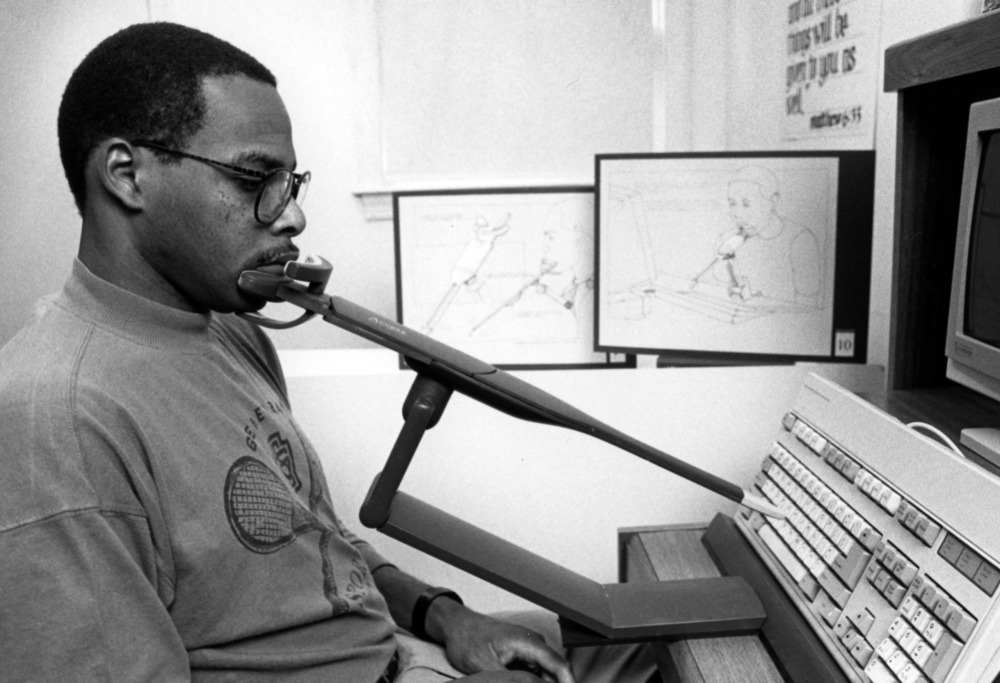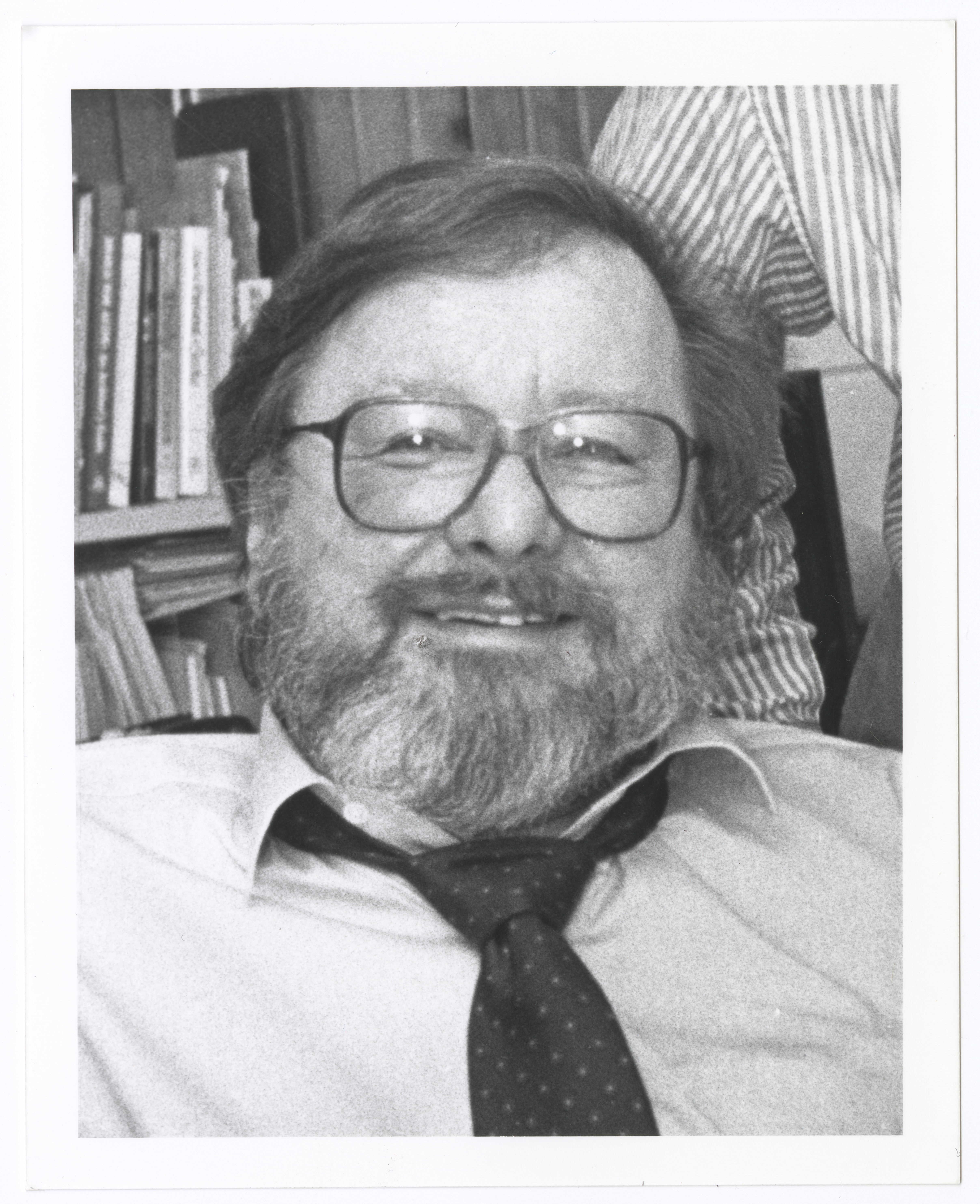
Graduate student Vincent L. Haley demonstrating his pointer device for computer accessibility. This is an example of how the College of Design addressed accessibility in design.

Graduate student Vincent L. Haley demonstrating his pointer device for computer accessibility. This is an example of how the College of Design addressed accessibility in design.
This blog is part of a series of posts featuring stories and photos from NC State’s College of Design, formerly School of Design. In celebration of the College’s 75th anniversary, the Special Collections Research Center (SCRC) created an exhibit titled “College of Design: 75 Years of Designing Tomorrow.” The exhibit opens in the D.H. Hill Jr. Library’s exhibit gallery after spring break March 2024. Graduate students Shima Hosseininasab, Kelly Arnold, and Alana Gomez worked together to create content for the exhibit and blog posts.
Though most of the exhibit focuses on the School’s most memorable and well-known designs, much can also be said about the students and faculty who stepped outside its traditional methods. Through courageous and unconventional initiatives, various students and faculty challenged normalized notions of who practiced design and who design served. This blog post profiles three of them.
Phillip Freelon (1975-2019) was among the earliest Black students to attend the School of Design in 1971. He transferred from Hampton University at the suggestion of architect John Spencer. Moving from a Historically Black College and University to a Predominantly White Institution was difficult for Freelon but not unfamiliar to his high school days. Though he recalled no overt racism towards himself or the other six Black students during his time there, he noted that Black students would often not receive the mentorship offered to other students.
Freelon graduated in 1975 and went on to receive a prestigious Loeb fellowship, have a highly successful practice and teaching career, and design major projects including the National Museum of African American History and Culture and the Houston Emancipation Park. After being diagnosed with Amyotrophic Lateral Sclerosis (ALS), Freelon also became an advocate for accessibility in design.
Watch an oral history interview with Freelon here and learn more about in an article published by the College of Design here.

In addition, Ronald L. Mace (1941-1998) was a nationally and internationally recognized architect, product designer, and educator whose design philosophy provided a design foundation for a more usable world. He coined the term "universal design" to describe the concept of designing products and the built environment to serve the needs of people regardless of their age, ability, or status in life.
Mace's pioneering work in the field of accessible design was instrumental in the passage of national legislation prohibiting discrimination against people with disabilities. His efforts include work on the 1973 Federal Rehabilitation Act which mandates accessibility requirements for federally-funded programs; the Fair Housing Amendments Act of 1988 which provides minimum accessibility requirements in all multifamily housing units; and the Americans with Disabilities Act of 1990 that incorporates major building, transportation, and communications design requirements guaranteeing equal opportunity to all people in public service businesses.
In 1989, Mace established the federally-funded Center for Accessible Housing, later known as the Center for Universal Design, at North Carolina State University's School of Design. The Center for Universal Design’s mission was to improve the built environment and related products for all users by impacting change in policies and procedures through research, information, training, and design assistance.
Learn more about the Center for Universal Design here.
In 1970, Linda Jewell was one of three women who graduated from the North Carolina State University School of Design with a bachelor's in architecture. During her time at the School, Jewell recalls discrimination against female architecture students. She remembers limited bathrooms, assumptions that female students were not going to make it in the field, and unwanted attention from faculty and senior members who were around.
Five years after her graduation from NC State, Jewell earned her master’s degree in landscape architecture from the University of Pennsylvania. Her distinguished career in education, practice, and publication is well recognized. She received the Presidential Award in Communications for her ten years of construction articles in Landscape Architecture magazine, and in 2008, she was awarded the Jot D. Carpenter Teaching Medal. Since 1991, Jewell has been a professor of landscape architecture and urban design at the University of California-Berkeley. She has been a fellow of the ASLA since 1994.
Learn more in an oral history with Jewell here.
“College of Design: 75 Years of Designing Tomorrow” opens in March 2024 in the exhibit gallery of the D.H. Hill Jr. Library. You can visit the exhibit during Hill Library’s hours for the rest of the year.
If you have any questions or are interested in viewing Special Collections materials, please contact us at library_specialcollections@ncsu.edu or submit a request online. The Special Collections Research Center is open by appointment only. Appointments are available Monday–Friday, 9am–6pm and Saturday, 1pm–5pm. Requests for a Saturday appointment must be received no later than Tuesday of the same week.